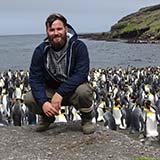
Apple Teacher
Education:Ph.D., University of California at Davis
B.Sc., University of Guelph
B.A., St. John Fisher College
I love birds - everything about them. As a scientist I think about how birds use their sense of smell to find food, to identify each other, etc. I am also interested in how we can use odors to influence a bird's stress. As a bird-geek I think about the beauty of flight, the wonders of plumage, the spectacular sounds that birds can make, etc. I keep a list of all of the birds I've ever seen and am always looking to see new birds. That said, I find equal beauty in all birds, common or rare.
Teaching
- BIOL 131/132/L - Anatomy and Physiology I and II (Lecture and lab)
- BIOL 314 - Advanced Human Physiology
- BIOL 317 - Animal Behavior
- BIOL 320 - Advance Human Anatomy
- BIOL 406 - Animal Natural History
- BIOL 410 – Conservation Biology
- BIOL 1110 - Data Analysis: Studying Nature
- HNRS 2512 - It's a Bird's World
Research
Students working with Dr. Cunningham can expect to work with birds either in the wild or on campus. Dr. Cunningham's research focuses on how birds use their sense of smell. In the early days of avian biology, birds were thought to not rely much on scents. We now know that a variety of birds, from albatrosses flying over the ocean hunting for prey to pigeons returning to their roost, use their sense of smell regularly.
In the field, Dr. Cunningham recently worked on the sub-Antarctic island of Kerguelen. There he lived among 100,000+ King penguins (Aptenodytes patagonicus), testing how they responded to a variety of scents.
This research demonstrated that these birds are able to detect a food-related odour. This may help to explain how these birds are able to locate productive areas of the ocean 100s of kilometers away. King penguins were also responsive to the scent of feathers and feces. These smells may be the basis of a colony scent, and the research suggests that birds may be able to locate the colony, or individuals within the colony, by scent.
Dr. Cunningham has also worked with the Southern African Foundation for the Conservation of Coastal Birds (SANCCOB) investigating the sense of smell of African penguins (Spheniscus demersus). There he showed that African penguins can detect a food-related odor. Current research focuses on whether or not penguins can detect fecal odors: a scent that many animals use as a way of recognizing individuals. Dr. Cunningham has previously facilitated research for Fisher students at SANCCOB.
Dr. Cunningham is also interested in how odors can be used to alter the stress physiology of a bird. Animals in a stressed state release a cascade of hormones that alter a variety of physiological processes.
A variety of researchers have successfully decreased stress hormones in rats by exposing them to a plant-derived scent and Dr. Cunningham is working with undergraduate students to do the same in birds.
The olfactory ability of raptors is understudied. Dr. Cunningham often works with Braddock Bay Raptor Research to address whether Red-tailed hawks (Buteo jamaicensis) are able to detect the scent of prey.
Although Dr. Cunningham focuses on olfaction in birds, he is generally interested in many elements of avian research. A student proposing research of a purely ecological or animal behavior-based study would be welcome in the lab.
Publications
- Does Accreditation by the Association of Zoos and Aquariums Correlate with Animal Welfare Act Compliance?, Journal of Applied Animal Welfare Science, DOI: 10.1080/10888705.2022.2028150, 2022. Co-authored with K. Riedman, L. DiVincenti.
- Embryonic exposure of chicken chicks (Gallus gallus domesticus) leads to heightened sensitivities towards the exposed scent. Behaviour, 154, 1361-1375, 2018. Co-authored with R. Hughes.
- Visual field shape and foraging ecology in diurnal raptors. Journal of Experimental Biology, 221, 1-9, 2018. Co-authored with S. Potier, O. Duriez, G.R. Martin, V. Bonhomme, C. O’Rourke, E. Fernández-Juricic E, and F. Bonadonna.
- The nose knows: How tri-trophic interactions and natural history shape bird foraging behavior, Teaching Issues and Experiments in Ecology, Vol. 13: Practice #8 [online], 2018. Co-authored with K. Bonner.
- Responses of King penguin (Aptenodytes patagonicus) adults and chicks to two food-related odours, Journal of Avian Biology, 48, 235-242, 2017. Co-authored with S. Leclaire, C. Toscani, and F. Bonadonna.
- Parental influences on the behavior of a juvenile Bornean orangutan (Pongo pygmaeus), The Review: A Journal of Undergraduate Student Research, 17, Article 8, 2016. Co-authored with R. McUmber and S. Robarts.
- King penguins can detect two odours associated conspecifics. Journal of Experimental Biology, 218, 3374-3376, 2015. Co-authored with F. Bonadonna.
- Responses of common diving petrel (Pelecanoides urinatrix) chicks to burrow and colony specific odours in a simple wind tunnel, Antarctic Science, 24, 337-341, 2012. Co-authored with R.W. Van Buskirk, M.J. Hodges, and G.A. Nevitt.
- Evidence for olfactory learning in procellariiform seabird chicks, Journal of Avian Biology, 42, 85-88, 2011. Co-authored with G.A. Nevitt.
- African penguins (Spheniscus demersus) can detect dimethyl sulphide, a prey-related odour. Journal of Experimental Biology, 211, 3123-3127, 2008. Co-authored with V. Strauss and P. Ryan.
- Behavioural responses of Blue petrel chicks (Halobaena caerulea) to food-related and novel odours in a simple wind tunnel. Antarctic Science 18, 345-352, 2006. Co-authored with R.W. Van Buskirk, M.J. Hodges, and G.A. Nevitt.
- The sense of smell in procellariiforms: An overview and new directions, Chemical Senses in Vertebrates, X. 403-408. 2005. Co-authored with G.A. Nevitt.
- Evidence for nest-odour recognition in two species of diving petrel. Journal of Experimental Biology 206, 3719 – 3722, 2003. Co-authored with F. Bonadonna, P. Jouventin, F. Hesters, and G.A. Nevitt.
- A comparison of the olfactory abilities of three species of procellariiform chicks. Journal of Experimental Biology 206, 1615 – 1620, 2003. Co-authored with R.W. Van Buskirk, F. Bonadonna, H. Weimerskirch, and G.A. Nevitt.